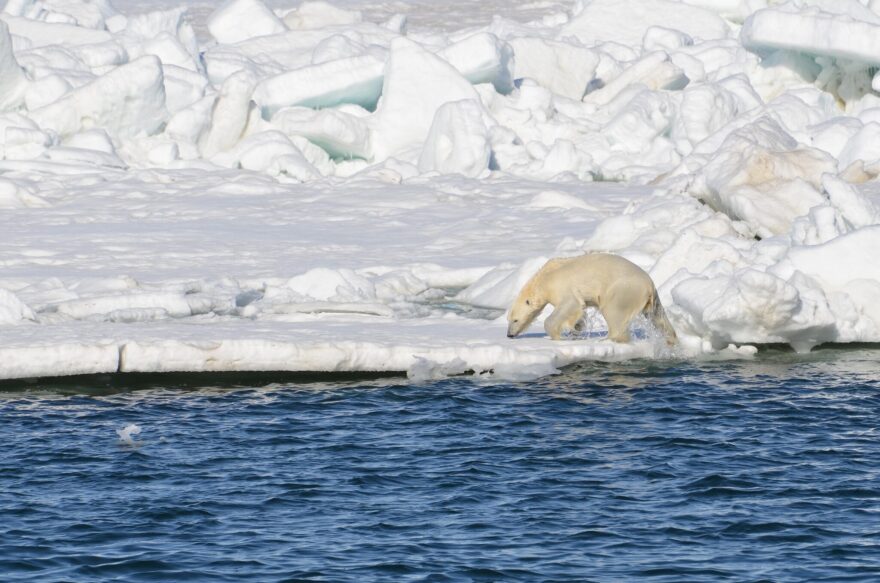Polar bears roaming the ice and swimming the waters of the Chukchi Sea have become increasingly exposed over the past decades to a collection of disease pathogens, according to a newly published study.
Regular monitoring by federal scientists showed big changes since the 1980s and 1990s in the markers of exposure to five disease-causing pathogens, said the study, led by the scientists with the U.S. Geological Survey based in Alaska and published in the journal PLOS ONE.
The study adds to a body of work showing movement of disease pathogens to far-north environments being transformed by climate change.
The study does not blame climate change for the increased exposure in the Chukchi Sea bears that make up one of Alaska’s two polar bear populations. It does not identify any particular cause, though it points out that the increase in exposure appears to be related to what the bears are eating from the marine food web.
What it does show is that conditions are now different in the environment that, up to now, has supported one of the world’s healthiest polar bear populations.
“There’s something changing in the environment that’s affecting pathogen exposure, whether it’s climate change-related or not,” said lead author Karyn Rode, a USGS biologist.
Whatever the reason for the increased exposure, it is a sign of potential future trouble for a high-profile Arctic population that, so far, has coped well with climate change, Rode said.
“It’s an additional stressor that we just highlight the paper that it’s something to keep an eye out for,” she said.
The study compares the results of blood tests taken from bears between 1987 and 1994 with those sampled between 2008 and 2017. The study tracked levels of antibodies in blood samples, which show responses to pathogen exposure.
Antibodies in those samples revealed increased exposure to five pathogens: Toxoplasma gondii, a parasite that causes food-borne illness; Neospora caninum, a parasite notorious for causing spontaneous abortions in cattle; Francisella tularensis, a bacterium that causes the disease tularemia, sometime referred to as “rabbit fever”; Brucella abortus and Brucella suis, the related bacteria that cause brucellosis; and the canine distemper virus.
The increase in exposure ranged from slightly under 30% for the canine distemper virus to 540% for Toxoplasma gondii, the study said.
The bear-monitoring scientists did not notice any signs that the animals were sick, Rode said.
Past studies of Arctic mammals’ increasing exposure to disease pathogens, including studies of polar bears from the struggling Southern Beaufort Sea and Hudson Bay populations, identified climate change as a likely influence.
The new Chukchi Sea polar bear study makes no such identification, even though — as with Alaska’s Southern Beaufort Sea polar bears — the Chukchi Sea bears have been spending more time on land as sea ice diminishes. More Chukchi bears are summering onshore and the time they are there has expanded by about one to two months a year over the past three decades, according to a previous study also led by Rode.
Unfortunately for Rode and other Alaska-based scientists, that land use by Chukchi bears is mostly on the Russian side, on the mainland in Chukotka region or on Wrangel Island. That makes data harder to obtain.
The increased pathogen exposure seems to come from the bears’ food, which is largely ringed and bearded seals, the study said.
“It could be that the pathogens are higher in their prey species than they were in the past,” Rode said. “That seemed like kind of one of the more likely scenarios.”
There is no solid information yet showing that Chukchi Sea polar bears have changed their diets.
Like Southern Beaufort Sea polar bears, Chukchi Sea bears have incorporated bowhead whales into their diets – and some pathogens that triggered antibody responses in the bears are associated with bowheads. Unlike the Southern Beaufort Sea bears, which are well-documented scavengers at bone piles left on shore by Alaska subsistence hunters, it is not obvious where Chukchi Sea bears are getting their bowhead food.
Among other polar bear populations, there is direct and plentiful information that animals are changing what they eat, likely to the detriment of their health. They have been found raiding bird nests to eat the eggs, hunting land animals like reindeer or increasingly foraging on trash left by people.
Getting more answers about what is happening with the Chukchi polar bear population may be difficult.
That population has always been more challenging to monitor than others, Rode said, because the animals are dispersed over a huge area stretching from the northern tip of Alaska to eastern Siberia.
Regular on-site monitoring of Chukchi polar bears has also become more precarious as the sea ice there weakens.
Such problems were especially bad in 2016 and 2017, when Rode and her colleagues found themselves trying to sample bears on ice that was drifting.
“What happened was that we got so much open water that the ice was moving really fast,” she said.
Even as they worked on individual bears, she said, “the GPS would not be actually telling us where we were on the ice because in five hours it moved five miles.”
A different challenge is the new barrier to information from Russia.
In the past, U.S. scientists worked closely with their Russian counterparts, including on Wrangel Island. But that cooperation became nearly impossible after Russia invaded Ukraine in 2022, resulting in a shutdown of those scientific exchanges.

